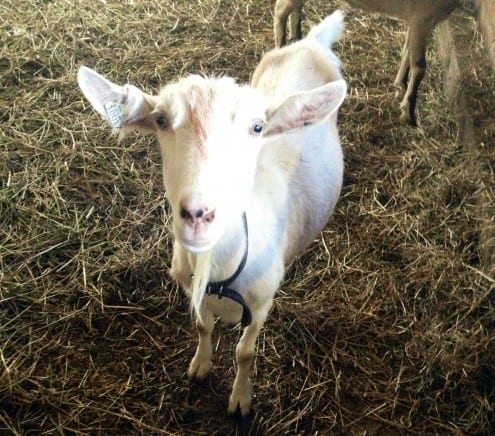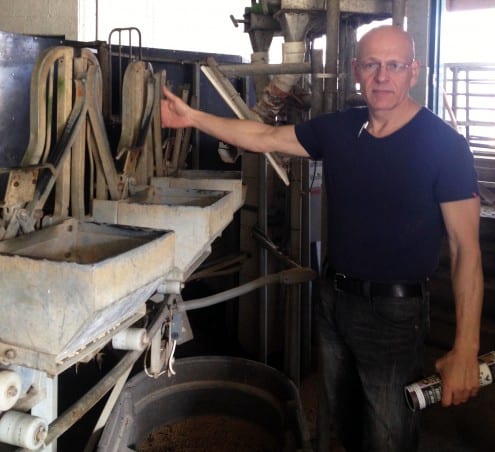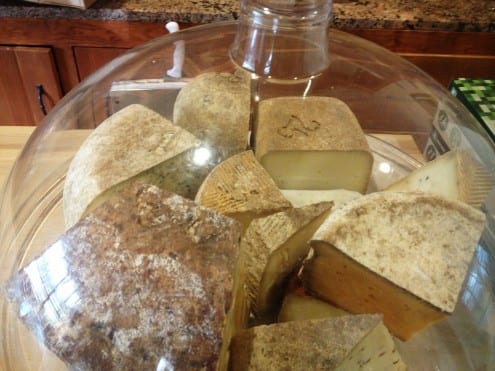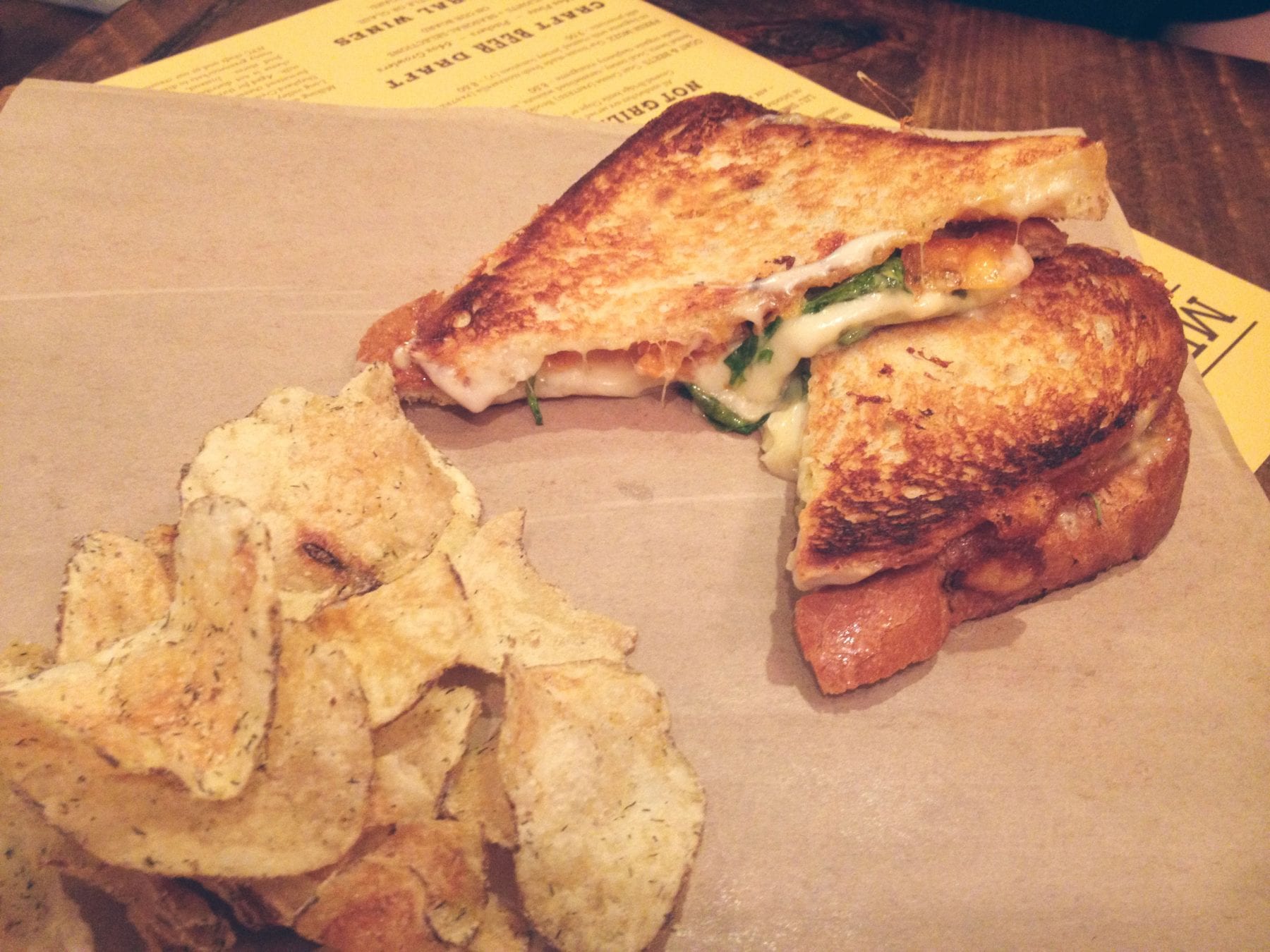At a farm in North Jersey, a team headed by an ex-engineer churns out European-style cheese to be turned into sandwiches with a nostalgic Americana twist.
By Hannah Keyser

“Oh, you are sweet, you’re a good one.” Eran Wajswol coos as he scratches the head of a particularly forward black-and-white goat. Soon, her multi-colored companions take note and start crowding the gate. The sheep, however, remain nonplussed. “Goats are smarter,” Warjswol offers as explanation. But the sheep’s milk makes for tastier cheese.
There are 600 sheep and 150 goats living on the 120 acre Farm in Long Valley, NJ known as Valley Shepard Creamery. The 50 cows live several miles away. There’s also one horse, named Pumpkin, on the property; but she’s just a pet. Twice a day, seven days a week, all the sheep and goats need to be milked. If that sounds like quite an undertaking, that’s because it is. But the whole thing is made more efficient, and frankly even more impressive, by a giant custom milking parlor.
A metal platform made in a small town just south of Barcelona, milking equipment built in Germany and electronic readers and computers from the Netherlands were all married here on this North Jersey farm into something that looks like a small livestock carousel. And this is how it works: The whole contraption rotates at a slow and steady pace. One by one, sheep or goats are herded up a shoot and onto the platform. A small container of grain prompts her to stay put until a harness locks her into place and the milking equipment is attached. Every five or six seconds a new sheep or goat gets loaded on and strapped in. By the time the parlor makes one full revolution, she is finished and trots off back to the pasture. It takes about two hours to milk all 600 sheep this way. It’s the only one of it’s kind in the United States.

“Look at this! Look at this fucking maze of fucking pipes and equipment!” Founder and owner of Valley Shepard Creamery Wajswol cries enthusiastically in his distinct accent that blends Israeli and Belgian roots. As far as I can tell, the more excited he is the more expletive-filled his speech becomes. He really loves the milking parlor.
“Somehow it all works, assuming we nurse it back to health about once a week,” he marvels at the behemoth of a machine. This is a common source of grumbling with Wajswol – grumbling, like salty language, being a sign of affection. There are too many machines – feed conveyor belts, refrigerators, cheese compressors, giant mixers, vats of temperature-controlled milk – that break and need fixing.
“Equipment everywhere. And I can assure you, every piece has failed and will fail again.” He sounds neither surprised nor flustered by the constant chaos. If anything, there is a sense of pride for the capricious nature of a fully operational, vertically integrated cheese farm. And, with all due respect to the farmers, fruit and vegetable farms can’t even compare, Wajswol confides.

To be fair to all the other farmers out there, Wajswol and his wife and partner in cheese making Debra, have a bit of a leg up on their peers when it comes to managing the more technical aspects of a farm. The couple met in engineering school and Wajswol spent most of his career as a high-rise developer in Hoboken before their vacations to Europe became an independent study in cheese making. Now in his mid-fifties – wiry, bespectacled and nearly bald he looks at once ancient and ageless – it’s easy to see how a background in the hard sciences and management would come in handy running this sort of operation.
First you have to make the cheese. Cultures are added to raise the pH level of the different milks. How acidic the milk is made will effect the final flavor of the cheese. Next, you add an enzyme called “rennet” which causes the milk to coagulate and separate into curds and whey. The curds are used for cheese making the whey is just a byproduct but sheep milk whey can be used to make ricotta which can then be compressed into ricotta salata. How hard the cheese will be is in part determined by how small you then cut the curds. The smaller the curd, the drier the cheese is. So Parmesan, for example, has a really tiny curd. Smaller curds have more overall surface area; increase the surface area you can expel more of the whey with pressure. The curds are gathered together into a single mass using a hot water bath. For buttery mozzarella, all that’s left is to soak in a brine mixture that adds saltiness to the super smooth cheese. More complex cheeses needed to be scooped into molds, compressed to expel whey and then aged for different lengths of time in the cave blasted out of the hillside on the farm by dynamite.
Over 30 types of cheeses are made at Valley Shepard Creamery (four of which are also made on site at the Reading Terminal Market), not to mention butter of an array of mouthwatering flavors, yogurt, and yogurt drinks (one particularly enamored customer regularly buys 12 of the addictive smoothie-like drink a week). They are then transported to be sold or turned into artisanal grilled cheese at a shop at the Reading Terminal in Philadelphia, or a shop in Park Slope, Brooklyn or to the associated grilled cheese cafe in the same neighborhood or to one of the 24 Greenmarkets located around New York City or to a chef in the area to be used on cheese plates in high-end restaurants. Le Bernardin and ABC Kitchen are among their customers. They also run cheese classes on the farm at the Reading Terminal, give tours of the farm every weekend, and host and house interns from across Europe.

And the whole process runs relatively smoothly. Enough to make you think that Wajswol and his team have this whole thing down to, well, a science. And in some respects, they do. For example, aside from just adding an air of nostalgic authenticity, the man-made cave on the property stays at a perfect cheese-aging 52-degrees Fahrenheit without the use of refrigeration. But like all masters of a craft, Wajswol understands that much of what sets Valley Shepard Creamery apart is more difficult to explain.
Hands and temperature: that’s what Wajswol and his wife traveled around Europe to see. From the Netherlands to the Basque region, even where he couldn’t speak the language Wajswol could check the temperature at which the curds were scalded and watch the hands of expert cheesemakers as they worked. It’s a passion and intimate understanding of European cheesemaking that Wajswol brought back with him and coupled with a dedication to producing artisnal cheese in batches he wants to keep small, no matter how successful the company gets.
“We can sell all the cheese we make right now,” Wajswol says of expansion. Although to be even having the discussion is a testament to how well things are going as Valley Shepard Creamery experiments with their newest means of distribution.

“MeltKraft came about because we were offered a space at the Reading Terminal and they wanted us to do something that sold our cheeses and we wanted to do something that showed off our cheeses in a unique way,” explains Rebecca Foxman, who was brought on to designs the recipes that would best utilize all the different cheeses. She is baby-faced and even shorter than this vertically-challenged author with a bubbly personality that might belay her credentials if you’re inclined to make snap judgements about the sort of people who would work as a manger at the Four Seasons before joining a cheese shop.
Luckily for their patrons, Foxman settled on grilled cheese as the best vehicle for get the cheesy goodness from plate to mouth. And so for three months before the stand opened this past January (at the Reading Terminal, the shop and restaurant operate out of the same space while in Park Slope a Valley Shepard Creamery shop has existed without the associated MeltKraft since 2011) Foxman stayed at the Farm, experimenting with dozens of grilled cheese recipes.
“I made about 50-60 different sandwiches,” she says. “And just wrote down every idea I had.” When it came time to narrow down the menu, Foxman prioritized an element of nostalgia in each of the sandwiches. Each one is named for the type of cheese it features but that’s hardly the whole picture.
“There’s something quirky about each one,” Foxman explains. ‘Valley Thunder’ contains the eponymous 12-month aged cheddar, of course. But it also has thick slabs of macaroni and cheese (using their own cheeses, of course) as well as brisket made fresh every day based on Foxman’s grandmother’s recipe. It’s a six hour process to make the brisket but there’s no cutting corners at MeltKraft.
“We make everything in house in both locations; and if we can’t make it we get it from someone local who makes it better than us,” Foxman assures. And the attention to detail has paid off.
The Reading Terminal location was such a smash hit that MeltKraft opened a second location in Park Slope in early September. It’s a beautiful space with a fireplace and two patios and a liquor license. And it’s already a neighborhood favorite. Wajswol and Foxman didn’t know for sure that that would be the case, but they had a pretty good idea.
When it comes to MeltKraft locations, as with their cheeses, it’s quality over quantity. Neighborhood is very important to Wajswol, who takes days out of his hectic schedule to just walk around getting a feel for the area when considering possible spots for MeltKraft No. 3. He’s checked out the Lower East Side in New York and the Rittenhouse Park area in Philly. He’s also had interest from other cities. But, as exciting as it is, there’s no need to rush.
“Where ever we are it works perfect,” he says without a hint of hyperbole in his voice. “Where is the next place that it will be perfect?” But surely he has some timeline in mind?
“In 2014, maybe.”













Valley Shepherd also offers terrific cheese-making classes at the farm in Long Valley, where you learn all about the processes used and get your hands into the curds. My friends and I took a class last month and loved it. Our hand formed cheeses are now now resting and ripening in the cave. Can’t wait to go back!